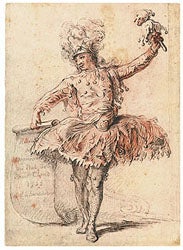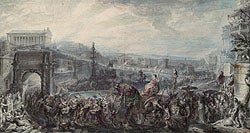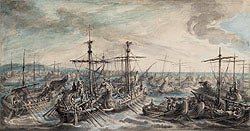Gabriel de Saint-Aubin (1724–1780)
October 30, 2007, through January 27, 2008
| |
 |
|
|
| |
Gabriel de Saint-Aubin (1724–1780), Momus,
1752, red, black, and white chalk,
The Morgan Library & Museum, New York |
|
|
This exhibition includes a prime selection of Saint-Aubin’s prolific and varied oeuvre, comprising some fifty drawings and a small but exceptional sample of his most memorable paintings and etchings. These selections will demonstrate the artist’s achievement in a variety of thematic areas, ranging from ancient history to portraiture to the decorative arts, while highlighting the representations of contemporary Paris for which he is best known. Several fine examples of a unique aspect of his work — the small art sale and exhibition catalogues that he filled with hand-drawn illustrations in the margins of the printed texts — also will be on view.
Gabriel de Saint-Aubin never left his native Paris. Born in 1724 into a family of skilled craftsmen, he was, by the age of twenty-three, teaching figure drawing in a school of architecture. He began his career as an illustrator supplying figures for elaborate architectural drawings that recorded municipal fêtes celebrating great events at court. He studied at the prestigious Royal Academy but failed to win the coveted Prix de Rome that would have provided him with a scholarship to study at the French Academy in Rome. He is often said to have reacted to this disappointment by throwing aside all hopes of a traditional artistic career and hastening out into the thoroughfares of Paris to sketch everything in sight, living an errant, bohemian existence and succumbing increasingly to an obsession with drawing. In fact, despite his personal eccentricities, he was employed as an illustrator all his life.
| |
 |
|
|
|
 |
|
|
| |
Gabriel de Saint-Aubin (1724–1780), The Triumph of Pompey (61 BC), 1765, watercolor and gouache, pen and black and brown inks, black chalk, and graphite, The Metropolitan Museum of Art, New York; and The Naval Battle near Ecnomus (256 BC),1763, watercolor and gouache, pen and black and brown inks, black chalk, The J. Paul Getty Museum, Los Angeles
|
|
|
The greatest illustration assignment of Saint-Aubin’s career was the Spectacle de l’histoire romaine, which preoccupied him for much of the 1760s. This project was the ideal vehicle for the artist’s vast erudition — his brother Charles-Germain said he could speak confidently with “professors in various sciences” regarding their respective fields of expertise — and it enabled him to combine his skills as a miniaturist, an architectural draftsman, and a keen observer of human behavior in a way that often is reflected in his scenes of contemporary life and history. The two masterpieces he created in connection with this enterprise recently were acquired by The Metropolitan Museum of Art (The Triumph of Pompey, above top) and the J. Paul Getty Museum (The Battle of Ecnomus, above bottom); both are highlighted in the exhibition.
A network of converging forces, rather than one lifelong obsession, caused Paris to become the dominant theme of Saint-Aubin’s formal and informal production. His early architectural drawings formed the catalyst for his interest in specifically Parisian themes — usually intertwined with intricate allegorical conceits that weave supernatural variations on contemporary reality. The combination of facts and fancy that characterizes Saint-Aubin’s earliest works will forever remain a hallmark of his art.
The reason his approach to Parisian subjects was so exciting and new is that he did not think of himself exclusively as a genre painter. He drew on every aspect of his richly varied artistic background to express a more immediate fascination with those events in Paris that were attracting differing degrees of local, national, and — sometimes — international attention. In his capacity as a commemorative illustrator, the artist had occasion to portray most major occasions in the lives of the French royal family between 1750 and 1780. As an associate of local architects and engineers, he glorified great building projects of national significance and visualized utopian schemes intended for the greater good of humanity. Developing an almost reportorial sense of current events, Saint-Aubin took it upon himself to capture for posterity such memorable occurrences as calamitous fires, the appearance in Paris of foreign dignitaries, public courses on scientific subjects, theatrical performances, and other lavish entertainments. Cumulatively, over the course of his lifetime, Saint-Aubin’s work became an embodiment of contemporary Parisian history.
Next Page >>> 1 2 3 4
Gabriel de Saint-Aubin (1724–1780) was organized for The Frick Collection by Colin B. Bailey, Peter Jay Sharp Chief Curator, and Kim de Beaumont, Guest Curator; the curators at the Musée du Louvre are Pierre Rosenberg, President-Director Emeritus, and Christophe Leribault, Chief Curator in the Department of Drawings.
Major funding for Gabriel de Saint-Aubin (1724–1780) has been provided by The Florence Gould Foundation. Additional generous support has been provided by The Christian Humann Foundation, the Michel David-Weill Foundation, and The Grand Marnier Foundation.
 |
|
The project is also supported, in part, by an award from the National Endowment for the Arts. |
|


